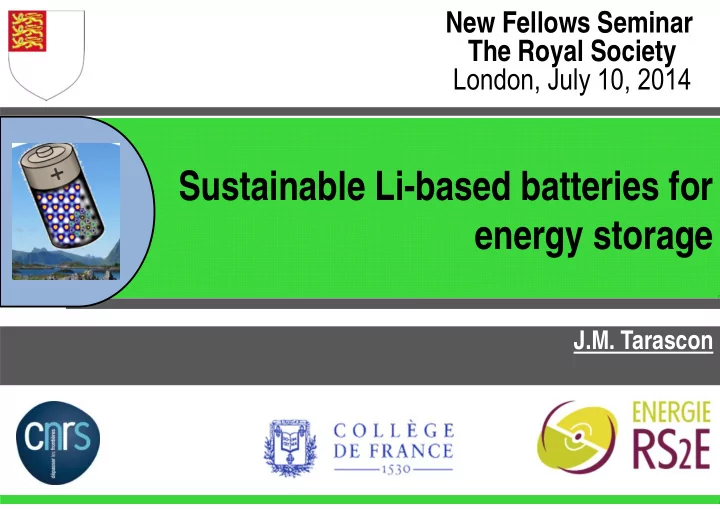

New Fellows Seminar The Royal Society London, July 10, 2014 Sustainable Li-based batteries for energy storage J.M. Tarascon
Today’s energy overview Energy transition http://americanenergyindependence.com/energychallenge.aspx Renewable energies Production, Transport, Conversion and Storage
Energy storage: Another challenge for the 21 st century To improve-create new energy storage technologies Grid EV applications applications Chemical Electric Batteries
The Li-ion technology: a versatile technology - + Energy LiMn 2 O 4 210 Wh/kg 4.2-5 V 625 Wh/l The Li-Ion technology Li x C 6 0.2 V LiCoO 2 -NMC 4.2- 4.6 V Power LiFePO 4 2 to 10kW / kg Li x Si y 3.45 V 0.4 V
The Li-ion technology: a large and diversified market Li-ion has conquered the portable market 2010’s 1990’s 18650 5-10 Wh What about the EV and grid applications markets: When ??? Grids packs 16 MWh EV’s pack 30-100 kWh Lower cost (/2) Higher energy (x2) SUSTAINABILITY
Tomorrow’s needs and challenges: Develop sustainable Li-ion batteries Today’s Cell assembly Ideal approach Raw materials Energy limitations demanding steps Energy How to reach this ??? demanding steps Improve materials synthesis Fabrication of a 1kWh battery Explore organic electrodes Energy needed 400kWh Search for post-Li chemistry 80kg CO 2 rejected Life Cycle Analysis of Large-size Lithium-ion Secondary Batteries; K Ishihara et al (2009). M. Armand, J.-M. Tarascon,Nature 451, 652 - 657 (2008)
New materials for energy storage: sustainability/cost issues Electrode Materials Elaboration Chemical ∑ ( ) ) ( + process composition Favour the use of low cost elements (Fe, Mn, Ti, S, P, C, B, Na, Mg)
Ionothermal synthesis of electrode materials Ionic liquids Lower synthesis temperature (200 C instead of 700 C) Tune morphology Molten salts at T amb. NaCl [EMI] + [TFSI] - Prepare new phases made of Inorganic abundant elements LiFeSO 4 F ionothermal synthesis??? N. Recham, … and J-M. Tarascon: Nat Mater. 2010, 9(1), 68-75.
Towards the eco-efficient development of electrode materials: a few trends Develop bio-assisted, bio-inspired synthesis methods Bacteria to synthesize New materials at Room Temp Control texture/morphology Bacteria/Viruses Diatoms Iron-oxidizing bacteria to produce -Fe 2 O 3 Energy (%) 40 nm Bacterium (Acidovorax Nanograins BoFeN1 ) of textured +Fe 2+ -Fe 2 O 3 30 C/2 days J. Miot…. and J.-M. Tarascon , Energy Environ. Sci., 2014,7, 451-460
Renewable organic Li-ion batteries: main message to take back home The organic alternative to the mineral approach O L iO O L iO O O Li 2 C 6 O 6 New concept PERFORMANCES Approaching those of present Li-ion batteries Meet SUSTAINABILITY M. Armand, J.-M. Tarascon,Nature 451, 652 - 657 (2008)
Can we increase the energy density while ensuring ecological storage? Gap of factor 15 Battery Petrol + air 150Wh/kg 2500Wh/kg Revisit the metal-air systems and more particularly the Li-oxygen one
Li-air vs. Li-ion in terms of performances Cell Cell Theoretical Theoretical Theoretical Energy density Potential Voltage Voltage Specific Energy Specific Energy Battery Battery Battery Wh kg -1 Wh kg -1 V (volts) V (volts) Today’s Li-ion Today’s Li-ion 3.8 3.8 387 387 ½ C 6 Li + Li 0.5 CoO 2 = 3C + LiCoO 2 ½ C 6 Li + Li 0.5 CoO 2 = 3C + LiCoO 2 Zn/air Zn/air 1.65 1.65 1086 1086 Zn + ½O 2 = ZnO Zn + ½O 2 = ZnO Li/S Li/S 2.2 2.2 2567 2567 2Li + S = Li 2 S 2Li + S = Li 2 S Li/air (non-aqueous) Li/air (non-aqueous) 3.0 3.0 3505 3505 2Li + O 2 = Li 2 O 2 2Li + O 2 = Li 2 O 2 Li/air (aqueous) Li/air (aqueous) 3.2 3.2 3582 3582 2Li + ½ O 2 + H 2 O = 2LiOH 2Li + ½ O 2 + H 2 O = 2LiOH Numerous technological barriers need to be overcome: the path will be long before Li-air batteries can be commercialized Bruce PG, …, Tarascon JM, Nature Materials, 11, 19-29, 2012 .
New Chemistries beyond Li-ion that we are exploring … Na-ion batteries Li/S batteries Multivalent cations All-solid-state batteries Redox-flow batteries (Mg +2 , Ca +2 ) batteries Most of them are still at the research-developpement level B.Dunn, ….. And , J.M. Tarascon, Science 334, 928 (2011);
Electric Vehicles: from the Holy Grail to today’s boom 1884 (Peugeot "iON“) 1899 (GM "Volt") (Bolloré "Bluecar“) 1942 Renault "Fluence" 1960 (Nissan "Leaf“) 1997 2013 Toyota "Prius" Great variety of models Moore’s Lead- Ni-Cd Li-ion Ni-MH Law ? acid 1900 1920 1940 1960 1980 2000
Energy storage: Meeting our challenges Double our energy production Develop new technologies (14 TW) Chemists New materials (28 TW) (2050) Constraints We do not have thousands of years ahead – our time is limited 2050 …. (35 years) Sustainability is becoming essential
How to defeat this time-scale bottleneck: Experimentation-Theory-Instrumentation Develop new materials Translate what has been done See better through eco-efficient methods in genomics to materials Finding the winning Can we dream … combination: a nightmare Electron Map a "genome of materials" imaging
Thank you all for your attention
Recommend
More recommend